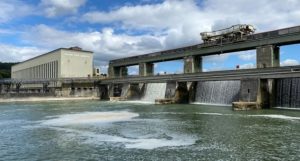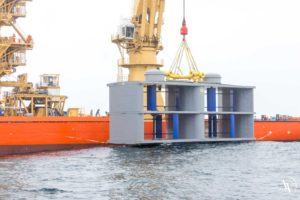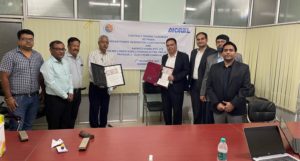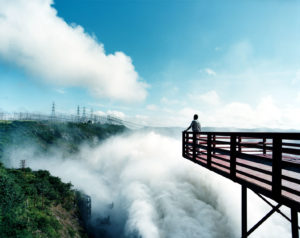KSB Bevron Volute Pumps for the UK’s Largest Water Pumping Station
St Germans Pumping Station is no ordinary land drainage pumping station. It is the largest pumping station of its type ever to have been constructed in the UK and it is built around six pumps each with the maximum capacity to raise 16.6 cumecs at a static head of 4.25m.
Moving this considerable volume of water has required a rather special design and size of pump and a more unusual approach to the construction of the pumping station. Such is the size of each pump; they weigh in at 19.5 tons a piece, the volutes and suction boxes had to be cast in situ, with the structure of the station being constructed around them.
Designed with a planned working life of 80-100 years, the Middle Level Commissioners have not taken any chances with the design and pumping capacity of St Germans. Six pumps may seem to be a luxury, but the station has been designed and built to address the worst possible disaster scenario. It will survive flooding should an upstream embankment breach occur and can run off its own internal power generation should the mains supply fail. In a typical year, it is envisaged that no more than three pumps will ever run at the same time.
Team effort
The pump design and construction brought together the design engineering resources of KSB Aktiengesellschaft with its proven SEZ vertical tubular casing pump and Bosman Watermanagement B.V., the developers of the Beveron concrete volute pump.
The planning and project management of the pumps’ installation was undertaken by KSB’s UK office, working with engineers from Bosman and KSB over an 18-month period. “Careful planning helped us to shorten the installation process by several weeks,” says Reimer Bojens, System Solutions KSB Aktiengesellschaft. “We allotted contingency time and fortunately, nothing of any significance went wrong. Much of our success lay in ensuring that where possible all pump parts were pre-assembled and factory-tested and stored off site. In addition we ensured that all the fixing and fastening components right down to individual washers, together with purpose-designed tooling and lifting equipment was labelled and available from our stores when required.”
The KSB/Bosman variable speed pumps use SCADA control and provide the facility to pump between 8 and 100 tons of water per second. This enables the station operators to choose exactly where in that capacity range they want to pump. In effect, any number of pumps can be called up and set to the speed required enabling managers to respond to conditions and to know how much water is pumped at any time.
It is possible to choose the most appropriate mode for the operating conditions. The most suitable operating mode can be selected manually, automatically and from off-site remotely via SCADA control. “With SCADA control, we can set the pumps to run at times of the day when we can take advantage of lower electricity tariffs,” says David Thomas, the Middle Level Commissioners’ Chief Engineer. “However, the sophistication of the SCADA program enables pre-set operating modes to be over-ridden if circumstances change. What is special about this program is that not only are we monitoring water levels at the pumping station, we are also referencing water level changes many miles away via a broadband link. If water levels increase in that location, the control systems will automatically set the pumps to work harder in order to reduce levels.”
The other useful thing about the SCADA system is that it is constantly accessing the pump curves provided by KSB. It looks at the drain and tidal levels and then looks at the pump curves to determine the most efficient operating speed can be attained. Unless this overridden, the pumps are always operating at optimum efficiency.
Pump design
The Beveron vertical pump is designed for easy lifting and inspection of all components, these being the pump stator housing, shaft, upper axial/radial bearing, shaft seal, lower radial bearing, removable wear-ring and impeller. The volute is designed specifically to match the KSB impeller and has a very high hydraulic efficiency. A feature of the volute is the flat floor and trapezoidal flow cross section. The construction of the removable cast iron wear-ring in which the bronze impeller rotates had to be to an exacting standard in order to ensure that it conformed to the profile of the impeller.
The maintenance and wear-free RESIDUR bearing operates without the need for external cooling or lubrication and should water levels drop to a very low level the pump will tolerate temporary dry-running during start-up. At St Germans, the design of the installation means that the open mixed flow impeller should be constantly submerged, which has the benefit of removing the need for priming when starting up the pump.
Although the suction conditions are fairly stable, the discharge head can vary between 8m and 0.5m above the suction. When low tides are encountered, there is the possibility that there is no discharge head at all. Thus, under high suction head and low discharge head, air extraction in the discharge main is required in order to enable full bore flow. To overcome low head conditions resulting in inadequate NPSHa variable speed drives have been incorporated.
The Bosman stator comprises a fabricated body, upper bearing set, shaft seal, bearing column and lower bearing set. The entire assembly is filled with 11³m. of water, this acting as a reservoir for the ‘liquidyne’ shaft seal. The upper bearing set of the stator is attached by flanges to the upper side of the load-bearing support flange. The shaft seal located on the pump cover on the bearing seat has an upper and lower arrangement and is lubricated by clean water from the stator. Two metering pumps are used for the seal flushing system, with half the clean water being returned to the stator storage tank and half flushed down the shaft past the lower seal and through the lower bearing. The presence of an inflatable shaft seal arrangement allows the shaft seal to be replaced under pressure in situ.
The upper bearing set holds the stator in place, absorbing the axial and radial forces imparted by the impeller. The lower bearing is non-wearing and because of its location in the impeller boss behind the impeller it has good heat transfer properties as it is in a submerged position. Coupled to the pump shaft and supported on a fabricated steel fame above the volute is the Preinfalk planetary gear box complete with motor lantern. This has a maximum output speed of 129rpm, but typically operates at 121rpm. Should it be necessary, the pump can be run beyond 50 Hz if required.
Installing the pumps
Work on the first phase of installing all six pumps commenced in August 2008 starting with the anti-rotation plates, followed by the form work for the in-take, removable wear-rings and suction bell. This was followed by casting the void for the removable wear-ring and grouting in the wear-ring itself. The final stage was placing the volute designed and manufactured by Bosman. The civil structure had to be constructed to very close tolerances in order to line up with the wear-ring, which was cast horizontally and level to within 0.1mm per meter. After that the volute form work was positioned centrally to the wear-ring.
The pump was accurately aligned to the wear-ring as it was essential that the nominal gap between the impeller and the wear-ring was no greater than 2.1mm. In practice KSB managed to attain between 1.9mm and 2.3mm along the whole length of the blades. When bearing in mind that the smallest diameter of the blades was 2.1m and the largest 2.65m, this was a considerable achievement. This phase of installing the pumps was completed in three months, after which work on the main structure of the pumping station commenced.
The second phase of the pumps’ installation started in July 2009 once the main fabric and infrastructure of the building had been constructed and the building made watertight. This mechanical work involved installing and aligning the pumps to the wear-ring, and installing the gear box frames, gear boxes, motors and all ancillary equipment.
The commissioning programme commenced in January 2010 and this was broken down into three stages. The first stage involved dry testing which involves testing all the instruments to make sure that the correct feedback was being obtained from all the protection devices. The next stage was to run the ancillary equipment, including the oil pumps and the seal flushing pumps, and to turn the machine over at 5Hertz, part of the control philosophy to ensure that the pumps never turbine backwards. When a pump is called to start, the ancillary equipment engages and the pump is instructed to go to 5Hertz and then remain there in slow rotation. During this period the penstock starts to open and if there is any backflow through the non-return valve the pump will not turbine because it is being driven forward. Once it is known that the penstock is fully opened, the pump will ramp up to the required speed.
“We went through and tested every pump to ensure that they would rotate happily at 5 Hertz and then kept them running for 5 hours,” continues Reimer Bojens. “In real life, if the penstocks do fail to open the default situation is for the pumps to remain at 5 Hertz until an engineer is in attendance to sort out the problem. The third stage was to re-circulate water at full chat and get the pumps up to full speed for 8 hours at duty point of 16.67cumecs at 4.25m static head.”
KSB formally handed the pumping station operation over to the Middle Level Commissioners in the second part of April 2010, following successful commissioning of four of the six pumps, thereby matching the pumping capacity of the old station. The new station went live at the end of April. The remaining two pumps were commissioned in December 2010 bringing the station capacity up to the design of 100 tonnes of water per second, at full load and against an average tide. Transfer of operation from old to new, which was performed in just four days, was critical as no pumping was available over this period.
Source: KSB SE & Co. KGaA







